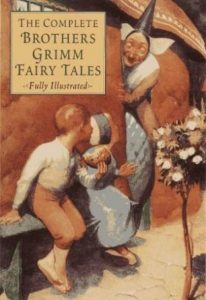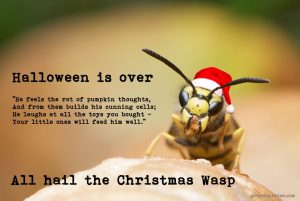How many people today have heard of Professor Ernst Stellmacher, author of Insekten-Archäologie für Frauen (1873)? Very few, we imagine. And yet it is to her that we owe most of what we know about the traditional myths and legends of the Christmas Wasp. This stalwart collector of North European myths once held a pivotal role in the field of folk-lore studies. Courted by antiquarians across Europe, Stellmacher was born not Ernst, but Steffi, and spent most of her life passing as a man in order to prosper in the universities of the nineteenth century.
Her paper Giftige Insekten in der frühen bayerischen Folklore (Venomous insects in early Bavarian folklore), written in 1865, was the first to document beliefs going back as far as the 1300s. Professor Stellmacher also sought and found connections to the Polish legends of the osa wakacyjna, or holiday wasp, and traced centuries of oral history through asides in diaries and literature.
Despite her efforts, by the end of the Victorian period, the Christmas Wasp was all but forgotten. Red cheeked Santas and Dickensian snow scenes had obliterated earlier and darker tales. The myth, if myth it is, survived only in small pockets of Jutland, in Denmark, the Faroe Isles, and the Yorkshire Wolds.
In South Jutland, the ceremony of the julen hvep is kept up by a few of the more established families, but these days consist only of baking dark rye and light wheat cakes, hvepekager (wasp cakes), symbolising the black and yellow of the Christmas Wasp, to leave out on the night of the Winter Solstice.
Where Does the Story Originate?
No one knows with any certainty. Early church records from Northern and Central Europe mention prayers against Yule-sting, an unexpected and painful swelling contracted by parishioners during the winter months, but some authorities believe the phenomenon to be related to the huddling together of families and the subsequent increase in flea bites.
In the 1600s we first see explicit mentions of der Wespenkönig, the Wasp King, and for two hundred years or more, stories flourished around this figure.
Der goldene Fisch des Teufels (The Devil’s Golden Fish), as presented by the Brothers Grimm in 1812 (not included in all editions), is perhaps once of the best examples.
A poor farmer and his wife had three daughters, but only one son. The daughters spent most of their time pretending to be geese and making slippers out of the slower squirrels in the area, so the farmer prayed that his son would become a lawyer. Hearing this, the Devil appeared to the farmer and said that he could make this happen, if the man only took the crops that grew below the ground.
After some dispute over a bumper turnip harvest and a passing Prince, whose dogs had unfeasibly large eyes, the Devil declared that he would take the man’s soul. The farmer offered to to cut off his own fingers with red-hot iron scissors, but as this made no sense, the Devil refused. So the farmer said that instead he would show the Devil where the finest honey could be found.
Taking the Devil to the woodshed that Yuletide, the farmer showed him a wasp’s nest, and said that if the Devil put his hand inside, he would find honeycomb better than any he had tasted before. Knowing that wasps don’t make honey anyway, and that all wasps are dead or asleep in winter, the Devil did as he was told, assuming this must be magic.
No sooner had the Devil inserted his hand than a large and angry insect appeared, stinging him so mightily that the Devil fled back to Hell. The farmer, who had merely been stalling for time, asked the wasp if there was any chance of a donkey who would produce a silver coin a day from his mouth. The Wasp King, highly irritated by now, stung the farmer to death and moved to a crack in a nearby elm tree. The rest of the family moved to Hamburg and became unsuccessful tailors.
The Wasp King and the Christmas Wasp are folkloric cognates, and interchangeable in many tales. Most scholars believe that the stories arose as a warning to communities that however well-behaved and Christian they were, life was uncertain. LaFroid pointed out in his 1885 study that the Christmas Wasp often doled out punishment at random, even with whimsical malice (Académie Française, archives).
Children were warned that if the Christmas Wasp came to them over the holiday period, they were on their own, so tough luck.
What is the Christmas Wasp?
Traditional stories indicate a wasp of considerable dimensions, more akin to an extremely over-sized European hornet. Originally depicted as a large insect with eight legs, perhaps related to the Norse myth of Sleipnir, he is always black and gold, and of stern expression. It is said that his buzzing noise is highly irritating, and a few discredited scholars have linked the legend of the Christmas Wasp with an early explanation for winter tinnitus.
Later depictions of him with a Santa hat on are of American origin. Although popular, these spring solely from the advertising efforts of McCarthy’s Cola, of Pennsylvania, around 1920 – “The cola with a sting in its tail”. McCarthy’s went out of business in 1921.
(Candy canes in America were originally striped in yellow and black, an oblique reference to the Christmas Wasp, but settlers of North European origin found it disturbing, and they were quickly changed to the red and white stripes common today.)
Although sometime referred to as ‘it’, he is undoubtedly masculine, and represents the single male in the nest who survives the Autumn, when all the others die. A counterpart to the quiet, sleeping queen, who will bring forth new life in the Spring, he is irascible and as noted, unpredictable. He can be placated, so Wolds legends have it, by offerings of raspberry jam left out between December 24th and 1st January. In Jutland, preserved bilberries are the more usual offering, and in the Faroes, salted fish (though this never works).
An East Anglian legend survives concerning the DeGranvilles, who have held the manor of Sweating Mowbray since the time of William the Conqueror. The death of a DeGranville is always preceded by the appearance of a spectral black dog around Christmas, forecasting doom to come in the following year. To avert this, each DeGranville heir keeps a wasp to hand during winter, in order to sting the dog on the nose and drive it away (Rev. Eustace Crumb, ‘Annals of Anglian Curiosities’, 1912). The connection with the story of the Wasp King is clear.
Curiously, there are no Scottish legends of the Christmas Wasp or Wasp King. The Reverend Crumb considered this to be because of the extraordinary number of bad-tempered midges which infest all Scotland, making the Christmas Wasp redundant.
And there you have it. We leave you with the words of the pioneering Professor Stellmacher:
“Noch ein Tag mit diesen idiotischen Männern, und ich schwöre, dass ich verrückt werde. Warten. Ist das die Weihnachtswespe oben auf dem Schrank?” (One more day with these idiotic men, and I swear that I shall go mad. Wait. Is that the Christmas Wasp on top of the wardrobe?)
Professor Stellmacher (1822-1894) was a heavy drinker in her later years.


